37 Plants That Thrive Under Trees: Flowers, Shrubs, Ground Covers, and Bulbs
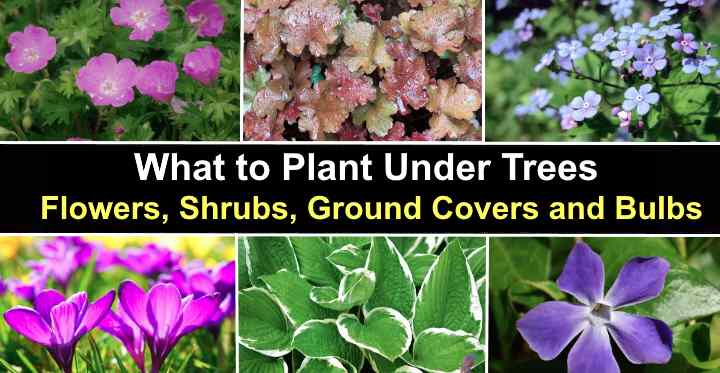
Choosing the right plants to grow under trees can be challenging. Plants growing around trees must compete for nutrients and moisture. Flowers, shrubs, and bulbs also must grow without much sunlight, tolerating constant shade from the tree’s canopy. However, there are plenty of flowers, shrubs, ground covers, and bulbs to fill empty, barren spaces under trees.
This article is a comprehensive guide on what plants to grow under trees. You will find suggestions for flowering perennials, bulbs, bushes, and low-growing ground cover plants that thrive in the shade. Descriptions and pictures of the best understory plants will help you choose the best options for your landscape.
The Challenges of Planting Under Trees
Planting under trees, especially evergreen ones, poses several challenges. The lack of direct sunlight creates shade, and the ground beneath these trees tends to be dry due to the roots absorbing much of the available moisture. Evergreen trees, particularly coniferous ones like pine, grow in acidic soil, which may not be suitable for all types of plants. These combined factors create a challenging environment for many plant species.
How to Choose the Right Plants for Planting Under Trees
When choosing plants for the area under trees, it’s important to consider factors such as the available light, soil type, moisture levels, and soil pH levels. Opting for shade-tolerant plants and those with shallow root systems can help minimize competition with the tree’s roots. It’s also crucial to select plants that are compatible with the existing soil conditions.
Some examples of plants that can thrive under trees include shade-tolerant perennials like hostas, ferns, and heucheras. Additionally, ground cover options such as foam flowers, anemones, and lamium can be excellent choices. It’s also worth considering evergreen options like lungwort and wintergreen to maintain greenery throughout the year. These plant varieties can help create a visually appealing and diverse under-tree garden while complementing the natural shade and soil conditions.
The Best Bulbs & Rhizomes to Plant Around Trees
Planting bulbs under trees adds color and beauty to shaded woodland areas. Bulbs are usually the first plants to flower in early spring, providing visual interest to a tree’s understory.
Lily of the Valley (Convallaria majalis)
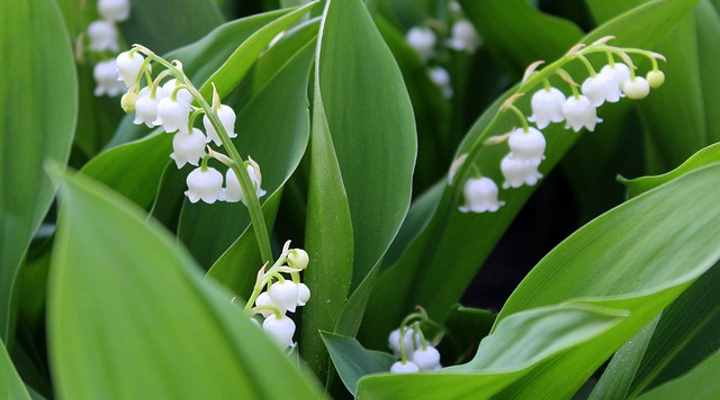
Lily of the valley is popular for planting under trees with dainty white, bell-shaped flowers nodding on arching stems. This understory woodland plant has attractive lance-shaped green leaves, up to 15 sweetly scented flowers per stem, and powerful floral aromas. The rhizomatous perennial is ideal for ground cover in the shade.
Lily of the valley injects a splash of bright color to woodland landscapes when it blooms in mid to late spring. Because the shade-tolerant plant prefers moist soil, planting it closer to the edge of the tree canopy is best. Or you could mulch around it to help retain moisture and subdue weed growth.
- USDA Planting Zone: 2 to 7
- Sun Exposure: Partial shade to full shade
- Blooming Season: Mid to late spring
- Mature Size: 6” to 12” (15 – 30 cm) tall and wide
Shade-Tolerant Anemones
Several anemone varieties bloom in early spring despite growing in the shade of trees. Low-growing, spreading anemone plants are recognized by their palmate, lobed leaves, and solitary, saucer-shaped flowers. The mat-forming native plants spread through underground rhizomes, quickly covering shaded areas underneath trees.
Here are three varieties of anemones suited to underplanting trees:
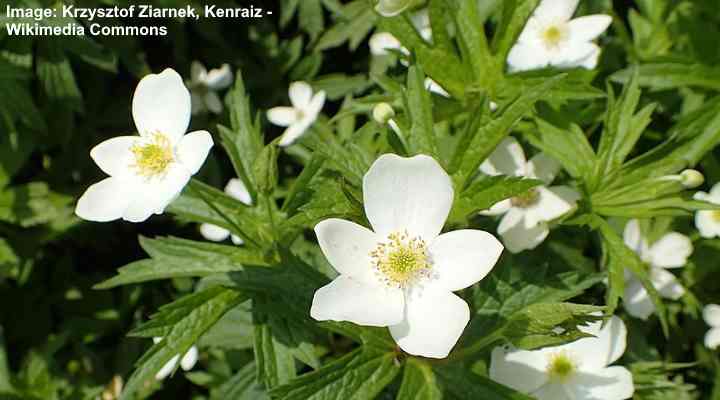
Meadow Anemone (Anemone canadensis)
Meadow Anemone (Anemone canadensis): This white-flowering ground-hugging plant blooms from mid-spring to early summer with masses of brilliant white, upward-facing flowers. The white, daisy-like flowers brighten shaded areas under trees, forming a natural ground cover and suppressing weeds to enhance the landscape. It is native to the United States and Canada.
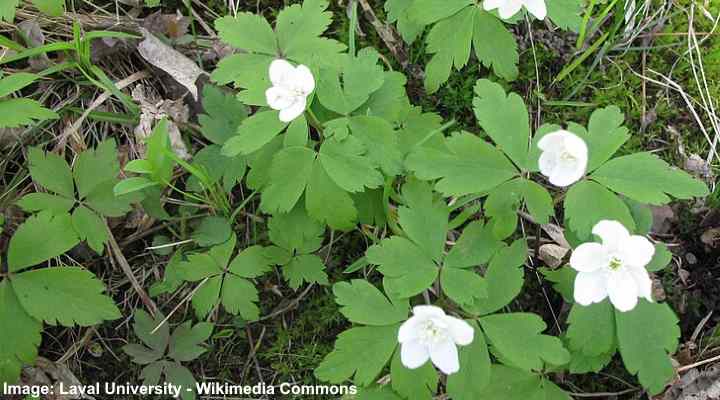
Wood Anemone (Anemone quinquefolia)
Wood Anemone (Anemone quinquefolia): This mat-forming plant is ideal for planting under trees due to its shade tolerance and spreading growth. The low-growing plant blooms in spring with star-shaped white flowers contrasting nicely with dark green, lobes leaves that look like five leaflets. This native wildflower supports pollinators and enriches the ecosystem of woodland floors.
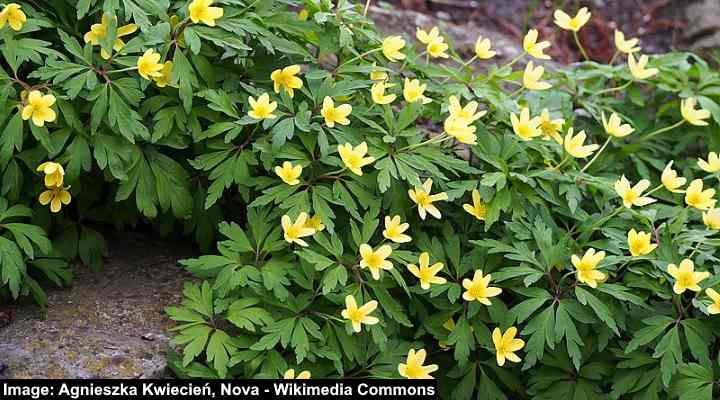
Yellow Wood Anemone (Anemone ranunculoides)
Yellow Wood Anemone (Anemone ranunculoides): Ideal for planting in partial shade at the edge of a tree’s canopy, this charming ground cover plant has bright golden-yellow flowers. The yellow blooms appear throughout spring, adding color and texture to woodlands.
- USDA Planting Zone: 5 to 8
- Sun Exposure: Partial shade to full shade
- Blooming Season: Mid to early summer
- Mature Size: 6” to 12” (15 – 30 cm) tall and wide
Snowdrops (Galanthus)

Common Snowdrops (Galanthus nivalis)
Snowdrops thrive in shaded areas under trees, filling spring landscapes with dainty white flowers. These perennial bulbous plants bloom early in the year. The flowers and grass-like foliage grow in clumps, spreading across areas with little sunlight. Not growing more than a foot (30 cm) tall, they provide color to bare landscapes.
Snowdrops are easy to grow and a great addition to a woodland understory. The early-blooming white flowers attract early-season bees and other pollinators. Also, the plant’s foliage is resistant to deer and rabbits, making them ideal for planting in rural landscapes.
- USDA Planting Zone: 3 to 8
- Sun Exposure: Partial shade to full shade
- Blooming Season: Late winter and early spring
- Mature Size: 4” to 10” (10 – 25 cm) tall and up to 6” (15 cm) wide
Crocuses (Crocus)

Crocuses are vibrant and colorful flowering bulbs for growing under deciduous trees. These small, bulbous perennials bloom in early spring with cup-shaped or tulip-shaped flowers in purple, yellow, white, and striped colors. Crocuses are great for adding a splash of color to spring landscapes.
Crocuses prefer full sun or partial shade. Because they bloom before deciduous trees leaf out, they are perfect for underplanting oaks, maples, beech, and poplar trees. The brightly colored flowers naturalize easily, forming a carpet of color beneath trees. The hardy bulbs are deer-resistant and attract early pollinators like bees.
- USDA Planting Zone: 3 to 8
- Sun Exposure: Full sun to partial shade
- Blooming Season: Late winter or early spring
- Mature Size: 3” to 6” (7.5 – 15 cm) tall and up to 4” (10 cm) wide
Grape Hyacinth (Muscari armeniacum)
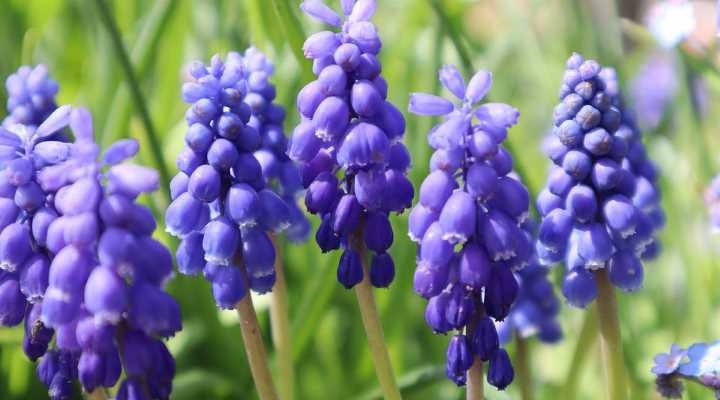
Grape hyacinth is a purple or blue-flowering bulbous plant for adding color around deciduous tree trunks. The easy-grow bulbs thrive in full sun or dappled sunlight. They bloom in spring with conical clusters of small, bell-shaped flowers. These fill landscapes with stunning blue, purple, and white shades. Its grass-like foliage adds texture under tree canopies.
Grape hyacinth is a low-maintenance plant that tolerates a wide range of well-drained soils. It prefers partial shade but can also handle full shade. Its fragrant flowers attract bees and butterflies to woodlands. Plant the bulbs in large groups for the best color when landscaping under trees.
- USDA Planting Zone: 4 to 8
- Sun Exposure: Full sun to partial shade
- Blooming Season: Mid to late spring
- Mature Size: 6” to 8” (15 – 20 cm) tall
Spanish Bluebell (Hyacinthoides hispanica)

Spanish bluebells work well underplanting evergreen trees and deciduous trees because they tolerate dry shade. The small bulbous plants have clusters of bell-shaped purple, pink or white flowers nodding on small, erect stems. These contrast beautifully with clumps of glossy green, strap-like leaves, adding color and texture to a woodland floor.
Spanish bluebell is a low-maintenance plant well-suited for growing under trees. The ground cover plants spread by self-seeding or bulb. Spanish bluebells are one of the most shade-tolerant flowers of all the varieties of spring bulbs. They also promote biodiversity in landscapes by attracting bees and butterflies.
- USDA Planting Zone: 3 to 8
- Sun Exposure: Full sun, partial shade, heavy shade
- Blooming Season: Mid to late spring
- Mature Size: 6” to 24” (15 – 60 cm) tall and wide
The Best Ground Covers for Planting Under a Tree
Planting ground cover plants under trees creates a visually appealing landscape in otherwise barren spaces. Additionally, mat-forming flowering plants help prevent soil erosion, suppress weeds, and conserve soil moisture. These features make maintaining the area under a tree’s canopy easier.
Hostas (Hosta)

Hostas—also called plantain lilies—are shade-loving perennials, ideal for planting in the deep shade of trees. Hostas are known for their large, attractive, broad oval leaves with pointed tips. The blueish-green, lime-green, or variegated leaves create a mound of thick foliage that provides ground cover under trees.
Perfect for shade planting, hostas create a lush understory garden. Typically not growing more than 2 ft. (0.6 m) tall, they bloom in early summer with small white or lilac flowers growing tall spikes. Their ideal habitat is growing in well-drained soils in partial to full shade.
- USDA Planting Zone: 3 to 9
- Sun Exposure: Partial shade or heavy shade
- Blooming Season: Early summer
- Mature Size: 1 to 2 ft. (0.3 – 0.6 m) tall and wide
Japanese Spurge (Pachysandra terminalis)
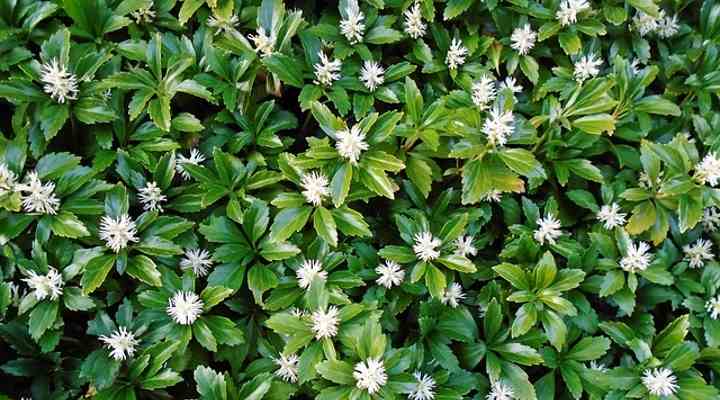
Japanese spurge is a popular evergreen ground cover plant for growing under trees. The shade-loving plant has foliage consisting of glossy, dark green, leathery leaves with toothed margins. The low-growing plant spreads through rhizomes, forming dense, carpet-like mats in woodland understories.
Japanese spurge is a tough, low-maintenance ground cover plant that’s resistant to pests and diseases. It’s also rabbit and deer-resistant. This plant is drought-tolerant, can handle dry shade, and is known for creating dense, carpet-like mats in shaded areas under trees. Apart from its lush foliage, it produces small, white flowers in early spring.
- USDA Planting Zone: 4 to 8
- Sun Exposure: Partial shade to deep shade
- Blooming Season: Early spring
- Mature Size: 3” to 6” (7.5 – 15 cm) tall and spreads indefinitely through rhizomes
Coral Bells (Heuchera)
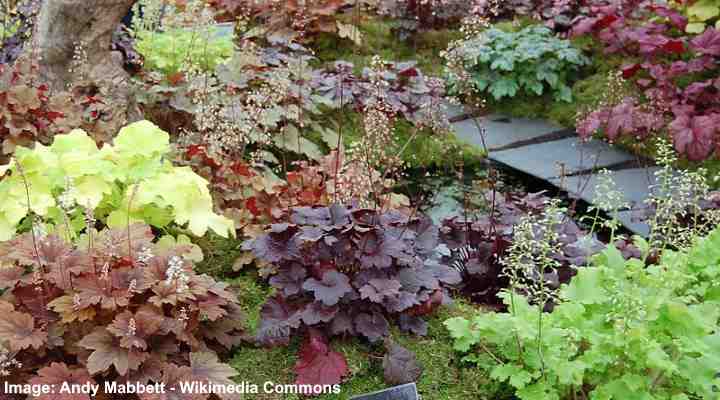
Coral bells are colorful, shade-tolerant perennials that are popular ground cover plants under trees. Coral bells plants are known for their attractive ruffled leaves in green, purple, bronze, and silver shades. The understory plant also produces clusters of delicate, bell-shaped pink, white, or red flowers in spring or summer.
Coral bells add color and beauty to areas under trees throughout the year. They thrive in dry shade and tolerate salt, deer, and drought conditions—ideal for growing under trees in coastal landscapes. Their attractive flowers on tall stems attract hummingbirds, bees, and butterflies. They are hardy plants and perform well in woodland gardens.
- USDA Planting Zone: 4 to 9
- Sun Exposure: Full sun, partial shade, or full shade
- Blooming Season: Early summer to mid-fall
- Mature Size: 8” to 24” (20 – 60 cm) tall and wide
Periwinkles (Vinca minor and Vinca major)
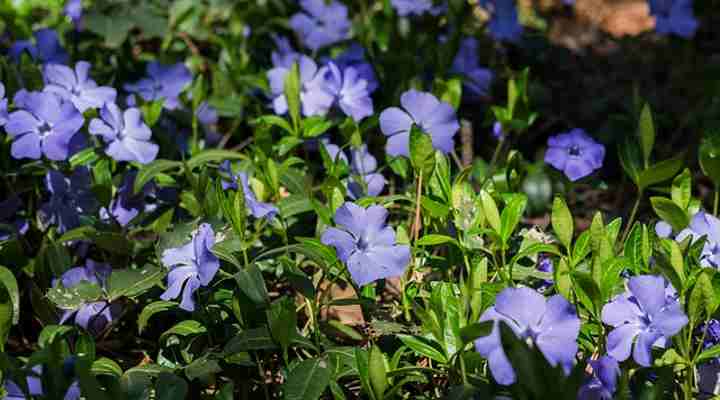
Periwinkle plants thrive in the shade of dense tree canopies. The mat-forming subshrubs have dark green, ovate leaves and large, violet-blue spring flowers. The leaves and five-petaled star-shaped flowers grow on long, trailing stems, quickly forming a lush, dense carpet of foliage. Apart from adding texture and color under trees, they help suppress weeds.
Big periwinkle (Vinca major): This ground cover plant has large purple flowers measuring 1.5” (4 cm) across. They bloom from mid-spring until fall. Tolerant of dry soil and full shade under trees. It grows 6” to 24” (15 – 60 cm) tall and up to 18” (45 cm) wide.
Lesser periwinkle (Vinca minor): This vigorous mat-forming perennial has large lavender-blue flowers and glossy, dark green leaves. It’s ideal for brightening woodland floors with its long-blooming purple flowers and evergreen foliage. It grows 4” to 6” (15 cm) tall and up to 24” (60 cm) wide.
- USDA Planting Zone: 4 to 9
- Sun Exposure: Full sun, partial shade, and deep shade
- Blooming Season: All spring and intermittently until fall
Japanese Painted Fern (Athyrium niponicum var. pictum)
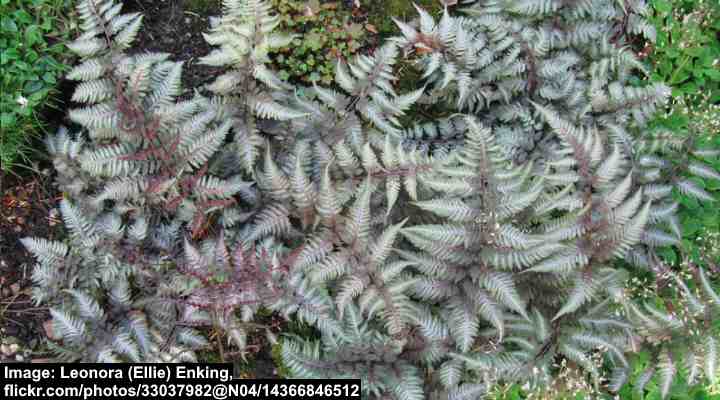
Japanese painted fern is one of the best ferns for growing under trees. The shade-friendly vascular plant is deciduous with striking fronds in silver, purple, burgundy-red, and green colors. Growing less than a foot (30 cm) tall, the delicate, lacy fronds add texture and color to shaded tree areas.
Japanese painted fern prefers moist, well-drained soil and can tolerate slightly acidic conditions. Depending on rainfall, planting the fern a few feet from the tree trunk is best to ensure moist soil. The fern grows in clumps up to 1 ft. (0.3 m) tall, ensuring lush ground cover under trees.
Japanese painted fern is relatively resistant to pests and diseases, making it a low-maintenance option for planting under trees.
- USDA Planting Zone: 4 to 9
- Sun Exposure: Partial shade to full shade
- Mature Size: 10” to 12” (25 – 30 cm) tall and up to 24” (60 cm) wide
Soft Field Fern (Polystichum setiferum)

Soft field fern is an ideal evergreen plant for growing in dry shade under trees. This fern has delicate, bright-green, lacy fronds that add soft texture to woodland gardens. The fronds emerge in a vibrant green color and mature to a dark green shade.
Soft field ferns thrive in most soil types and are relatively drought-tolerant once established. The easy-care ground cover ferns require minimal care and only occasional watering in the driest climates once established. Their bright evergreen foliage also brightens dull, shaded areas under trees during winter.
- USDA Planting Zone: 6 to 8
- Sun Exposure: Partial shade to heavy shade
- Mature Size: 2 to 3 ft. (0.6 – 1 m) tall and wide
Common Oak Fern (Gymnocarpium dryopteris)
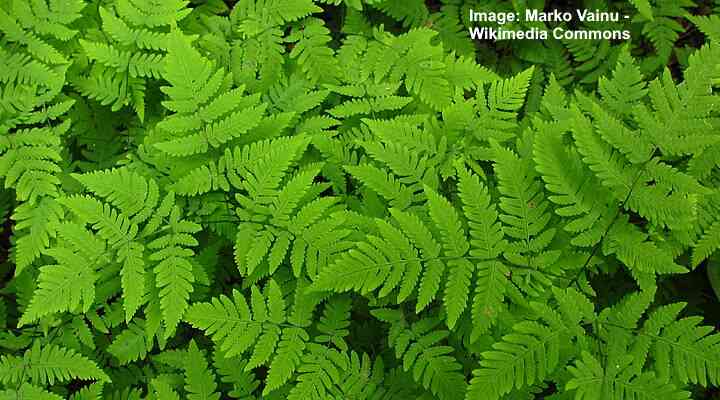
Common oak fern is a shade-loving evergreen vascular plant that fills bare areas under trees. This native fern has delicate, lacy triangular fronds growing 16” (40 cm) long. New leaves emerge in early spring and remain green throughout the season. The ferns grow best under pine and coniferous trees, and are not found near oak trees despite their name.
Common oak fern prefers slightly acidic soil and partial to full shade. Although it prefers moist soils, it can tolerate dry conditions once established. Its clump-forming, spreading nature makes it ideal for creating a lush and natural look in coniferous woodlands.
- USDA Planting Zone: 2 to 7
- Sun Exposure: Partial shade to full shade
- Mature Size: 6” to 16” (15 – 40 cm) tall and wide
Barrenwort (Epimedium spp.)
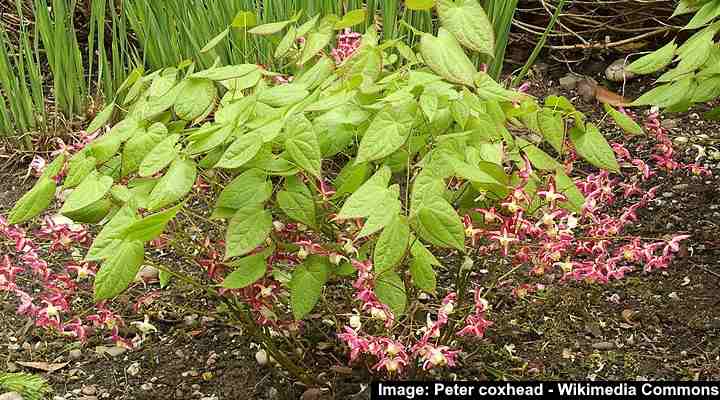
In the picture: Red barrenwort (Epimedium × rubrum)
Barrenwort is a group of low-growing flowering ground cover plants that thrive under dense tree canopies. Barrenwort blooms in spring with two-tone flowers resembling small orchids. The flowers bloom in yellow, pink, purple, and white shades, contrasting with the plant’s heart-shaped leaves. The leaves sometimes have a spotted appearance.
Barrenwort thrives in the shady conditions tree canopies create. The attractive ground cover plants help suppress weeds and prevent erosion. The intricate flowers attract pollinators, and the ground cover provides shade for small wildlife.
Barrenwort can grow in slightly acidic or neutral soil and is deer-resistant. And its minimal care requirements make it a great addition to pine woodlands.
- USDA Planting Zone: 5 to 8
- Sun Exposure: Partial shade or full shade
- Blooming Season: From mid-spring for several weeks
- Mature Size: 8” to 24” (20 – 60 cm) tall and wide
Lenten Roses (Helleborus)
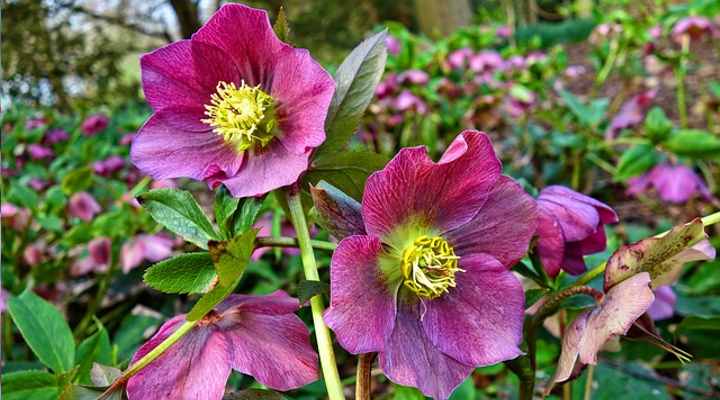
Evergreen lenten roses—also called hellebores—have an early blooming season and attractive foliage for brightening woodland floors. The shade-loving perennial plant’s large, cup or saucer-shaped flowers bloom in white, pink, purple, green, and dark burgundy-black shades. The nodding, showy flowers bloom on stems, adding a unique floral display under tree canopies.
Lenten roses have attractive evergreen foliage with leathery, serrated leaves. The evergreen leaves provide interest in shaded woodlands in summer, fall, and early winter when the plants are not in bloom. Hellebores are self-seeding and quickly create a carpet of foliage and flowers under trees. Additionally, they are deer, rabbit, and frost-resistant.
- USDA Planting Zone: 4 to 9
- Sun Exposure: Partial shade to full shade
- Blooming Season: Late winter to early spring
- Mature Size: 1 to 2 ft. (0.3 – 0.6 m) tall and wide
Lungwort (Pulmonaria)
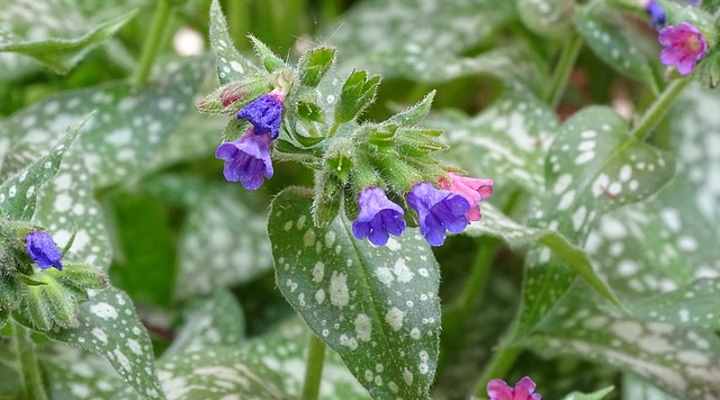
Lungwort is a shade-loving herbaceous perennial with colorful early spring blooms that brighten areas under trees. Lungwort flowers are small, trumpet-shaped blooms growing in clusters on erect stems. The flowers bloom in pink, purple, red, and violet shades. Lungwort lanceolate leaves have striking spotted or splashed patterns with silver or white markings.
Lungwort is an excellent plant for adding color and interest to shady areas under trees. Although it tolerates full shade, it prefers moist, well-drained soils. Therefore, it’s best to use lungwort for landscaping areas partially shaded around the tree’s canopy.
- USDA Planting Zone: 3 to 9
- Sun Exposure: Partial shade to deep shade
- Blooming Season: Spring to early summer
- Mature Size: 8” to 12” (20 – 30 cm) tall and wide
Wild Geranium (Geranium maculatum)
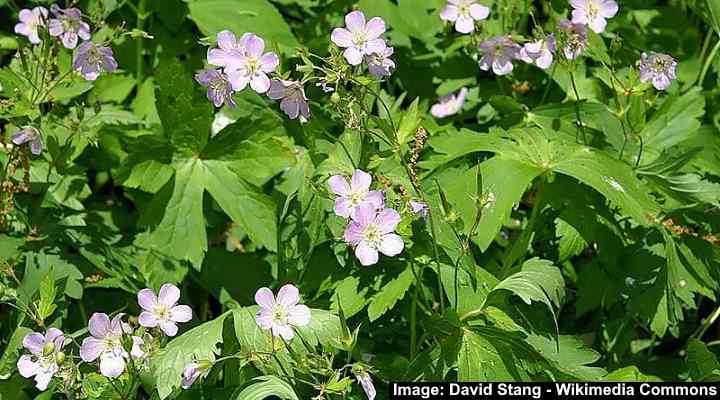
Also called cranesbill, wild geranium is a low-growing flowering plant that thrives in dry shade under trees. Ideal for partial shade or dappled sunlight, wild geranium has small clusters of large saucer-shaped pink, blue, red, or white five-petaled flowers. Its foliage consists of deeply lobed leaves with toothed margins.
The flowers and foliage of cranesbill add texture and color to areas around trees. The hardy perennial is native to deciduous woodlands in eastern North America. It is easy to grow and blooms for seven weeks from late spring. In addition to brightening areas at the edges of tree canopies, the fragrant flowers attract pollinators like bees and butterflies.
- USDA Planting Zone: 3 to 8
- Sun Exposure: Full sun, partial sunlight, light shade
- Blooming Season: Late spring throughout summer
- Mature Size: 1 to 2 feet (0.3 – 0.6 m) tall and wide
Bugleweed (Ajuga reptans)
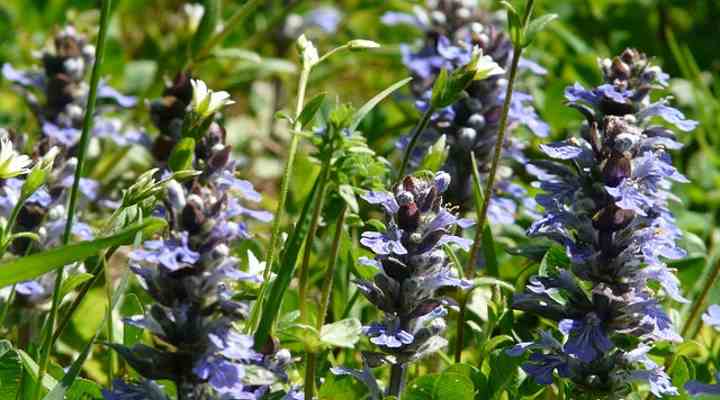
Bugleweed is a blue or purple-flowering ground cover plant that thrives in dry shade close to tree trunks. The tree companion plant is known for its glossy, dark green leaves and spikes of small, blue, purple, pink, or white spring flowers. Bugleweed’s dense, spreading habit makes it ideal for filling bare areas under trees.
Bugleweed thrives in challenging growing conditions where other flowering plants struggle. Besides being a deep shade plant, its robust root system and dense foliage prevent erosion and weed growth. It also attracts pollinators when its fragrant flowers appear from late spring through summer.
- USDA Planting Zone: 3 to 10
- Sun Exposure: Full sun, partial shade, heavy shade
- Blooming Season: Spring and early summer
- Mature Size: 4” to 8” (10 – 20 cm) tall and spreads indefinitely through its above-ground stems (stolons)
Sweet Woodruff (Galium odoratum)

Sweet woodruff blooms in late spring, and its white star-shaped flowers brighten understory tree areas. This mat-forming perennial has sweet-scented white flowers with small petals in a pinwheel form. These contrast delightfully with the lush, green carpet of emerald-green foliage. The shade-loving perennial is perfect for growing under pine trees.
This low-growing ground cover thrives in moist, well-drained soil and spreads quickly through rhizomes.
Sweet woodruff is known for its aromatic leaves that emit a sweet fragrance crushed. Growing this ground-hugging plant under trees adds a touch of beauty and fragrance to shady areas. Sweet woodruff is also deer-resistant and attracts pollinators like bees and butterflies. As a bonus, you can collect and dry the leaves to use in potpourris.
- USDA Planting Zone: 4 to 8
- Sun Exposure: Full shade to partial shade
- Blooming Season: Late spring and early summer
- Mature Size: 5” to 6” (13 – 15 cm) tall and 12” (30 cm) wide
Hakone Grass (Hakonechloa macra)
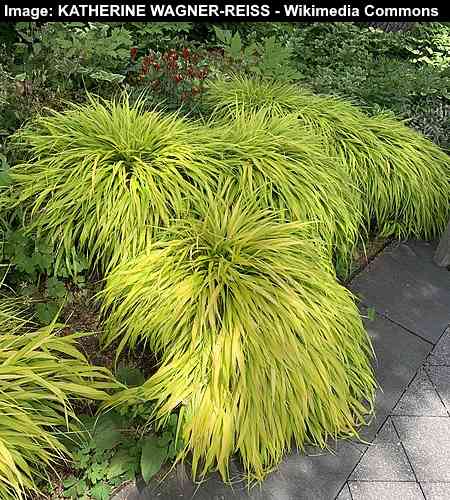
Hakonechloa macra ‘All Gold’
Hakone grass is an eye-catching ornamental grass that thrives under the canopies of large trees. Also called Japanese forest grass, the plant produces a clumping mound of slender, arching blades. These create a graceful, flowing effect in shaded understories. It’s sun, drought, and cold-tolerant and easy to propagate.
Growing hakone grass under trees is ideal for adding texture and movement to shaded landscapes where traditional grass cannot grow. The decorative grass tolerates a range of light conditions and performs well in dry shade. Additionally, the grass is deer-resistant and low-maintenance, requiring minimal care once established.
Other Japanese forest grass cultivars can add dramatic colors to woodland landscapes. Here are a few landscaping ideas:
Hakonechloa macra ‘Naomi’: Growing up to 2 ft. (0.6 m) tall, the shade-loving grass has variegated strap-like pointed blades in creamy yellow and green colors. These transform to purplish-red foliage in the fall.
Hakonechloa macra ‘Nicolas’: This Japanese forest grass has green foliage that turns fiery red, orange, and gold colors in fall.
Hakonechloa macra ‘Stripe it Rich’: This is one of the most striking ornamental grasses for underplanting trees. It has golden yellow and green variegated arching leaves forming attractive clumps.
- USDA Planting Zone: 5 to 9
- Sun Exposure: Full sun, partial shade, or deep shade
- Mature Size: 1 to 2 ft. (0.3 – 0.6 m) tall and wide
Cast Iron Plant (Aspidistra elatior)
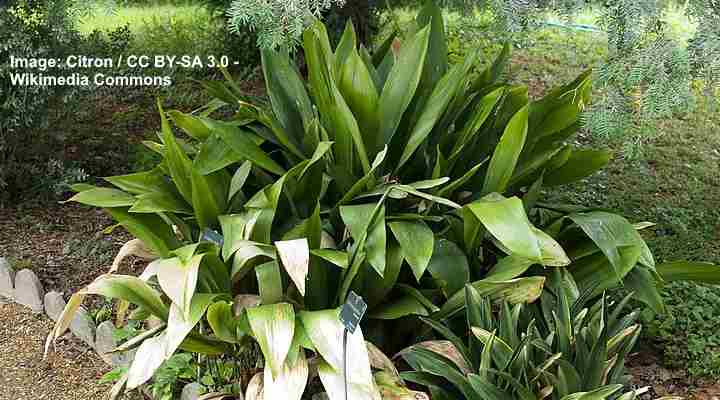
Cast iron plant is a tough, hardy, evergreen perennial that thrives in dense shade under trees. The eye-catching plant is characterized by its glossy, dark green leaves and upright growth habit. Its elliptical leathery leaves grow up to 6” (15 cm) long and have distinctive veins.
The plant’s name, cast iron, comes from its ability to withstand neglect, tough conditions, and pests, making it an ideal choice for underplanting trees. The leafy plant thrives in most soil types and tolerates dry shade. However, it performs best in climates with mild winters, making it an ideal ground cover plant for Florida.
- USDA Planting Zone: 7 to 11
- Sun Exposure: Dappled sunlight to full shade
- Blooming Season: Rarely blooms
- Mature Size: 2 to 3 ft. (0.6 – 1 m) tall and wide
Canada Wild Ginger (Asarum canadense)
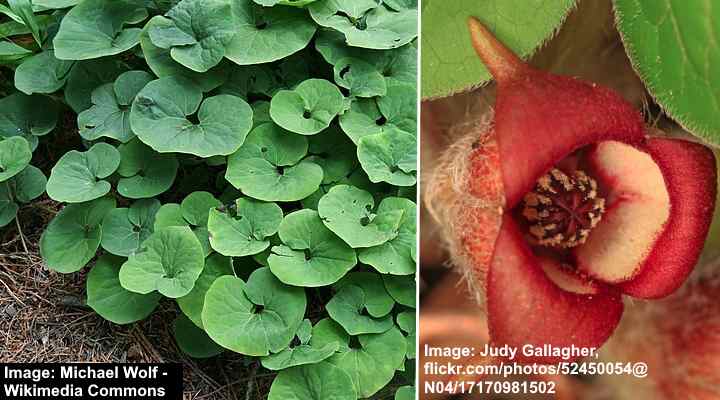
Canada wild ginger is a native of eastern North America, perfect for planting under trees and tall shrubs. It thrives in shade and is recognized by its kidney-shaped, dark green deciduous leaves and bowl-shaped, reddish-brown flowers. While it is a flowering plant, it’s primarily valued for its foliage as the flowers are small and inconspicuous.
Canada wild ginger spreads slowly through rhizomes, gradually filling bare patches of ground under trees. It grows well in all soil types that have good drainage. Also, its robust root system and thick foliage help suppress weed growth under the trees. It adds a touch of beauty to shaded areas or natural woodland settings.
- USDA Planting Zone: 4 to 6
- Sun Exposure: Partial shade to full shade
- Blooming Season: Early spring through fall
- Mature Size: 6” to 12” (15 – 30 cm) tall and up to 24” (60 cm) wide
The Best Perennial Flowers for Planting Under a Tree
Shade-tolerant perennial flowers are ideal for planting under trees. They typically have long blooming seasons and require little attention once established. Perennial flowers add texture and color to your understory landscape.
Siberian Bugloss (Brunnera macrophylla)

Siberian bugloss is a beautiful shade-tolerant perennial that thrives in deep shade under tree canopies. The plant features lush foliage of heart-shaped green leaves with silvery patterns. It also has sprays of starry blue flowers that look like forget-me-nots. These attractive flowers bloom from mid-spring through summer.
Siberian bugloss adds a bright splash of color to shaded areas under trees. The bushy mounding perennials grow up to 2 ft. (0.6 m) tall. Some Siberian bugloss cultivars have variegated yellow and green, green and white, or silver and green foliage.
- USDA Planting Zone: 3 to 8
- Sun Exposure: Partial shade to heavy shade
- Blooming Season: Mid-spring until late summer
- Mature Size: 1 to 2 ft. (0.3 – 0.6 m) tall and up to 3 ft. (1 m) wide
Blue Lily Turf (Liriope muscari)

Liriope muscari grass on the left and variegated type on the right (Liriope muscari ‘Variegata’)
Blue lily turf creates a sea of evergreen foliage and purple flowers in shady conditions created by dense tree canopies. The plant’s characteristics are tufts of arching, dark green narrow leaves and erect spikes of small, violet-blue or purple-pinkish flowers growing up to 8” (20 cm) tall. The attractive grass-like flowering plant is a great lawn alternative under trees.
Blue lily turf thrives in deep to partial shade. However, it prefers moist soil, so planting it a few feet from the tree trunk, closer to the drip line, is best. The trouble-free tuberous perennial is tolerant to heat, humidity, drought, and deer, making it highly versatile in shade gardens or understory planting.
- USDA Planting Zone: 5 to 10
- Sun Exposure: Full sun, dappled sunlight, partial shade, deep shade
- Blooming Season: Late summer through fall
- Mature Size: 12” to 24” (30 – 60 cm) tall and wide
Bamboo Iris (Iris confusa)

Bamboo iris is a unique, eye-catching white-flowering plant that tolerates partial shade at the tree canopy edge. This evergreen plant has stunning white orchid-like exotic flowers with six petals and wavy edges. Its sword-shaped leaves grow on bamboo-like stems, and its creeping habit forms thick clumps under trees.
The large white flowers on bamboo iris can grow up to 2” (5 cm) in diameter, and up to 75 flowers can be on a single plant.
- USDA Planting Zone: 9 to 11
- Sun Exposure: Full sun or dappled sunlight
- Blooming Season: Spring and early summer
- Mature Size: 2 to 3 ft. (0.6 – 0.9 m) tall and wide
Persian Violet (Cyclamen coum)

Persian violet is an early spring-blooming plant that thrives under trees in dappled sunlight or partial shade. The delicate plant blooms in early spring with upward-facing flowers in shades of pink, white, or purple at the top of reddish, erect stems. Its heart-shaped bluish-green leaves have silver marbling patterns.
Persian violet adds beauty to landscapes at the edge of tree canopies. It thrives in well-drained, moist soils and spreads through tubers to create masses of lush foliage and pretty pink to purple flowers.
- USDA Planting Zone: 4 to 8
- Sun Exposure: Partial shade
- Blooming Season: Late winter to early spring
- Mature Size: 3” to 6” (7.5 – 15 cm) tall and 8” (20 cm) wide
Foam Flower (Tiarella cordifolia)
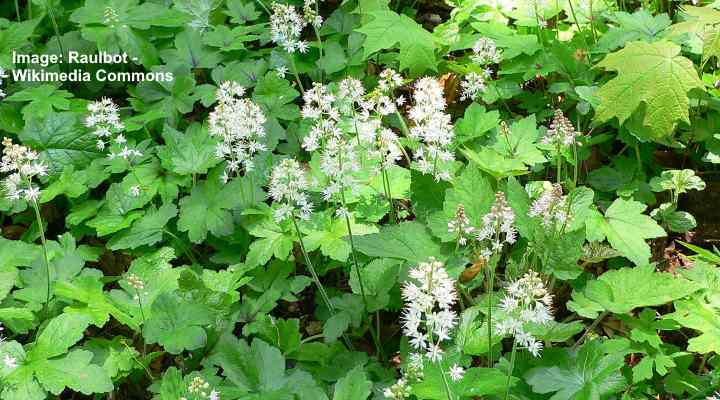
Foam flower is an eye-catching, low-growing perennial with clusters of starry, creamy white flowers. Thriving in the shade of trees, foam flowers have cylindrical flower clusters on erect stems appearing in late spring. These contrast nicely with heart-shaped green leaves that turn reddish-bronze in winter.
Foam flowers quickly naturalize into large colonies through their stolons. They perform well in partially shaded landscapes in well-drained, humus-rich, moist soils. Planting them under tree canopies where they get moisture from rainfall is best.
- USDA Planting Zone: 3 to 8
- Sun Exposure: Partial shade to full shade
- Blooming Season: From late spring and blooming for six weeks
- Mature Size: 6” to 12” (15 – 30 cm) tall and up to 24” (60 cm) wide
Columbine (Aquilegia)

Texas Gold Columbine (Aquilegia chrysantha ‘Hinckleyana’)
Columbine is a beautiful flowering plant that grows well around the edges of tree canopies. The eye-catching features of the perennial are its spurred, bell-shaped nodding flowers in yellow, pink, white, red, purple and blue shades. It also has fern-like foliage that grows in attractive clumps. Columbine blooms in late spring to early summer.
Columbine adds vibrant colors to partially shaded areas. It’s self-seeding and easily naturalizes in open woodlands to create a mass of beautiful flowers and lush foliage throughout the growing season. They also attract hummingbirds and butterflies, making them a great addition to garden landscapes.
- USDA Planting Zone: 3 to 9
- Sun Exposure: Full sun to partial shade
- Blooming Season: Late spring to late summer
- Mature Size: 1 to 3 ft. (0.3 – 1 m) tall and up to 2 ft. (0.6 m) wide
Baltic Parsley (Cenolophium denudatum)
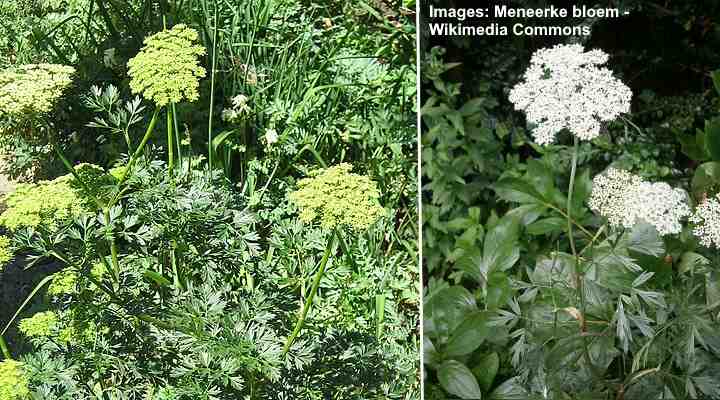
Baltic parsley is a charming white flowering perennial that thrives in dry shade near tree trunks. The attractive features of the semi-evergreen plant are its finely divided, fern-like leaves and flat-topped lacy clusters of creamy-white or greenish-white flowers. Its long blooming period lasts from mid-summer through mid-fall, growing up to 4 ft. (1.2 m) tall.
Growing Baltic parsley under trees serves several purposes. First, its graceful appearance contrasts beautifully with the tree’s woody structure. It also adds bright color and texture to shaded areas under dense tree canopies. Additionally, Baltic parsley suppresses weeds, stabilizes soil, and enhances the overall aesthetics of woodland understories.
- USDA Planting Zone: 6 to 9
- Sun Exposure: Full sun, partial shade, or full shade
- Blooming Season: Mid-summer until mid-fall
- Mature Size: 3 to 4 ft. (1 – 1.2 m) tall and up to 2 ft. (0.6 m) wide
The Best Annual Flowers for Planting Under a Tree
Planting annuals (or tender perennials that are grown as annuals) under trees adds seasonal color and interest to shaded areas. They’re easy to change yearly, require minimal maintenance, and can brighten up the landscape beneath tree canopies.
Begonias
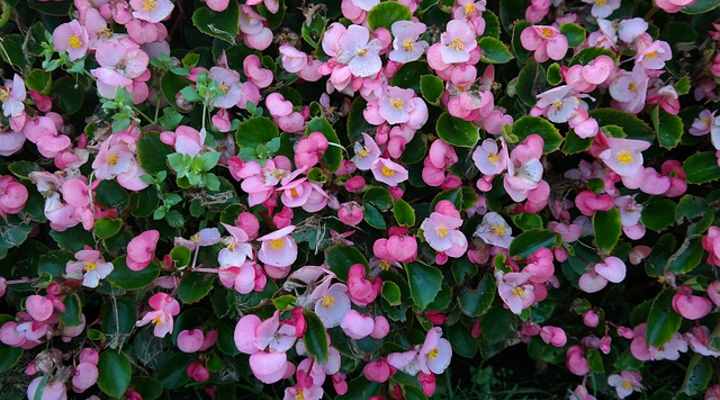
Wax begonia (Begonia Semperflorens-Cultorum)
Begonias are popular bedding annuals for planting under trees. Many cultivars have stunning flowers that bloom throughout the season, from spring until frost. The flowers can be single or double and bloom in orange, yellow, white, pink, and red shades. Also, begonias have attractive, colorful leaves that can be shaped like hearts, spirals, or stars.
The fast-growing annuals perform best along edges a few feet from tree trunks. They benefit from regular moisture but will perform well in deep shade to add color and vibrancy to a landscape area if they get enough water.
- USDA Planting Zone: 7 to 11, depending on the variety
- Sun Exposure: Partial shade or full shade
- Blooming Season: Early spring until frost
- Mature Size: 1 to 2 ft. (0.3 – 0.6 m) tall and wide
Impatiens
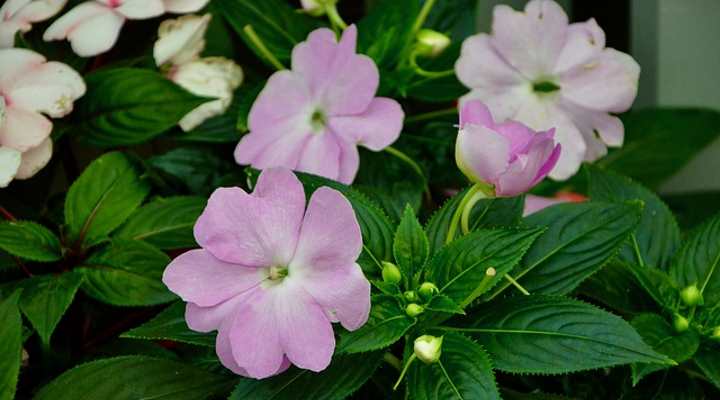
Impatiens are popular annual flowers for growing under trees because they thrive in shade. Impatiens flowers are single or double-blooms and flower continuously throughout the season. Some showy double bloom flowers resemble romantic roses. They appear in late spring, and varieties of impatiens bloom in pink, red, orange, purple, white, and multicolor shades.
Impatiens have a bushy habit and are ideal annuals for flowering ground cover in the shade. The easy-to-grow plants also attract hummingbirds and pollinators like bees and butterflies to shade gardens and woodland understories.
- USDA Planting Zone: 10 and 11
- Sun Exposure: Partial shade to full shade
- Blooming Season: Late spring until fall
- Mature Size: 10” to 24 inches (25 – 60 cm) tall and wide, depending on the cultivar
The Best Shrubs to Plant Under a Tree
Planting shrubs under tree canopies enhances the landscape by adding structure, texture, and beautiful flowers.
Evergreen Azaleas (Rhododendron)
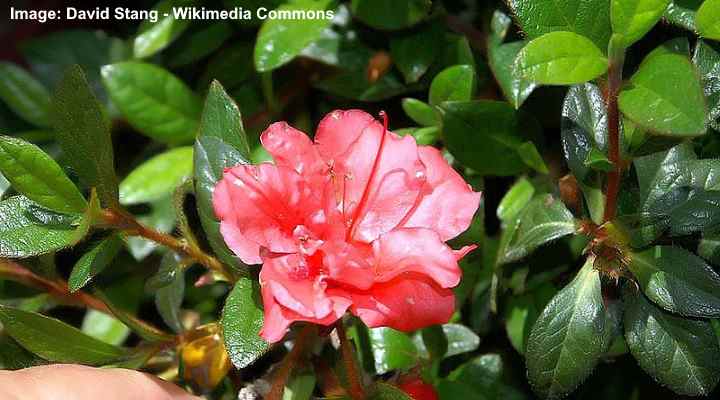
Encore Azalea ‘Autumn Princess’
Evergreen azaleas are popular shrubs for underplanting trees because they tolerate acidic soil and shady conditions. Not growing more than 3 ft. (1 m) tall, Encore azaleas produce abundant clusters of trumpet-shaped flowers, blooming in spring in pink, red, purple, and white shades. These create vibrant displays against the lush dark green leaves growing densely on the understory shrub.
Low-growing evergreen azaleas grow best a few feet from the tree trunk, closer to the canopy’s edge. Their shallow root system makes them excellent companion plants for underplanting trees. They add vibrant colors to tree landscapes, and the evergreen shrubs rebloom in summer and fall.
- USDA Planting Zone: 6 to 10
- Sun Exposure: Full sun and light shade
- Blooming Season: Spring to early summer
- Mature Size: 2 to 3 ft. (0.6 – 1 m) tall and wide
Japanese Laurel (Aucuba japonica)
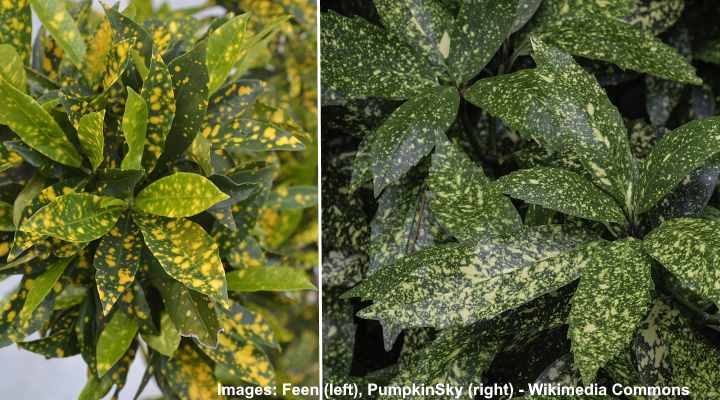
Japanese laurel adds vibrancy to areas under tree canopies thanks to its variegated foliage, small purple flowers, and bright red berries. This evergreen shade-tolerant shrub performs well at the edge of tree canopies. It is easy to grow in organically rich, moist soil that drains well.
Low-maintenance Japanese laurels can grow up to 10 ft. (3m) tall. Therefore, it’s important to ensure you plant it under tall trees for the best effect. However, being a relatively slow-grower plant, it is easy to prune the specimen shrub to maintain a desired shape or size under smaller trees. It’s ideal for year-round color and texture in partial to heavily shaded areas.
- USDA Planting Zone: 6 to 10
- Sun Exposure: Partial shade to full shade
- Mature Size: 6 to 10 ft. (1.8 – 3 m) tall and up to 9 ft. (2.7 m) wide
Red Osier Dogwood (Cornus sericea)
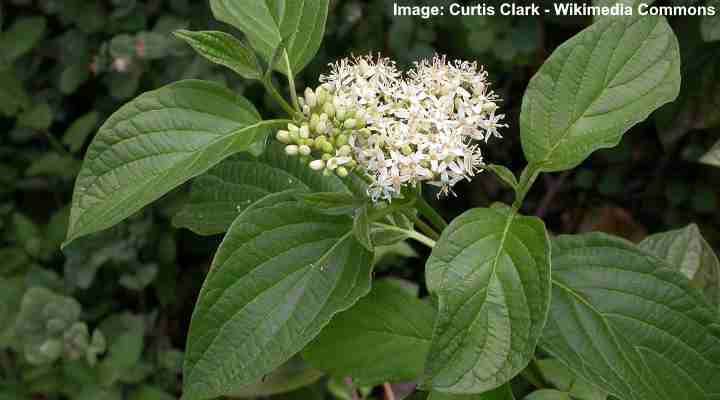
Red osier dogwood is a popular ornamental shrub that thrives in the dense shade of trees. This deciduous shrub has several landscaping features for a woodland landscape. It blooms in spring with flat-topped clusters of creamy-white flowers. The shrub has dark green leaves that turn rich red-purple in the fall and stunning white berries.
Red osier dogwood shrubs prefer moist, well-drained soil in full sun to part shade. Therefore, it’s best to plant them a few feet from the trunk, where they get enough moisture. It also has stunning winter colors with vibrant red or golden stems.
- USDA Planting Zone: 3 to 8
- Sun Exposure: Full sun, partial shade, or deep shade
- Blooming Season: Late spring and sporadically through summer
- Mature Size: 6 to 9 ft. (1.8 – 2.7 m) tall and 8 to 12 ft. (2.4 – 3.7 m) wide
Summersweet (Clethra alnifolia)
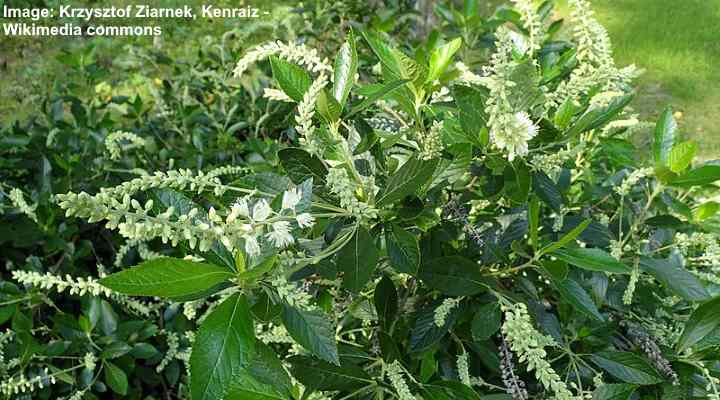
Clethra alnifolia ‘Hummingbird’
Summersweet is a spreading shrub with white flowers that thrives in the deep shade of trees. The features of the deciduous shrub are its white, fragrant bottlebrush flowers, summer blooming period, dark green foliage with yellow fall colors, and clusters of dark brown fruits. The suckering shrub spreads slowly, forming large colonies.
Summersweet is ideal for adding beauty and fragrance under deciduous and coniferous pine trees. Because they prefer moist, acidic soil, planting the understory shrubs toward the edge of the tree’s canopy is best. In addition to its shade tolerance, summersweet performs well in coastal areas and soggy ground.
- USDA Planting Zone: 3 to 9
- Sun Exposure: Full sun, partial shade, or full shade
- Blooming Season: Late summer to early fall
- Mature Size: 3 to 8 ft. (1 – 2.4 m) tall and 4 to 6 ft. (1.2 – 1.8 m) wide
How to Prepare the Planting Area Under Trees
Before planting bulbs, perennials, or shrubs under trees, remove weeds or grass using a hand trowel. Trying to dig out the weeds risks damaging the tree’s shallow roots. Also, don’t build up soil under the tree or around its flare because it may lead to potential issues and damage the tree.
How to Plant Under Trees
To plant under trees, start by removing the grass in the shaded areas. Spread a 2-inch layer of compost or well-rotted manure on the soil surface to improve soil aeration. You can also incorporate this organic matter into the soil to a depth of 4-6 inches, being mindful not to disturb the tree roots.
When planting, use small-sized plants to minimize root disturbance, and place the new plants in open spaces between the tree’s roots. Water the new plants deeply but infrequently. Add 2-4 inches of organic mulch after planting to retain soil moisture and moderate soil temperatures.
Common Mistakes to Avoid When Planting Under Trees
When planting under trees, avoid building up soil directly against the tree trunk, as this can harm the tree. Refrain from planting shrubs taller than three feet (1 m), as they can compete with the tree’s lower branches. Additionally, avoid rototilling the ground around an established tree, as it can damage the roots.
Lastly, don’t build a raised bed around the base of the tree as it may prevent the uptake of oxygen by the roots and lead to the tree’s demise. Roots will quickly fill the raised bed as the tree roots search for water, nutrients, and oxygen. These precautions can help maintain the tree’s health and create a successful garden under its shade.
How Should You Design and Layout Trees?
When designing your tree landscape, create layers of planting for visual interest, placing taller plants at the back and shorter ones towards the front. Enhance aesthetics with mulch or decorative rocks and reduce competition with tree roots.
How to Water Newly Planted Plants Under Trees
To water newly planted plants under trees effectively, ensure deep and thorough watering without overdoing it. Water the plant directly using a hose or watering can aimed at the plant roots. Mulching the area around the plants helps retain moisture, reducing the need for frequent watering.
What is The Best Time To Plant Under Trees?
The best time to plant under trees is during the early spring or late fall. During these periods, the temperature is moderate, which helps root establishment and minimizes stress on the plants. Spring planting allows the roots to develop before the heat of summer, while fall planting enables the plants to establish themselves before the onset of winter. Avoid planting during extreme temperature conditions, as this can negatively impact the plants’ ability to acclimate and grow.
Related articles:
